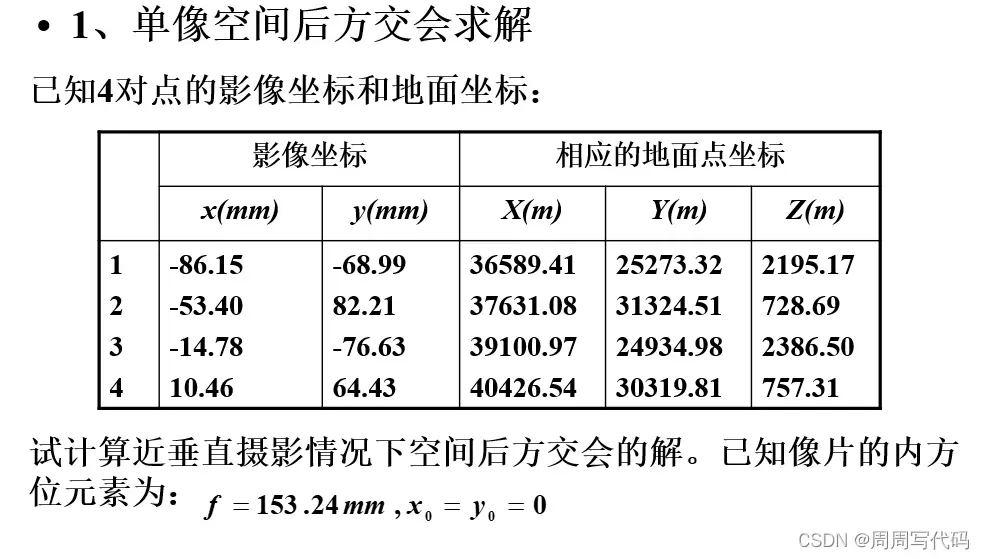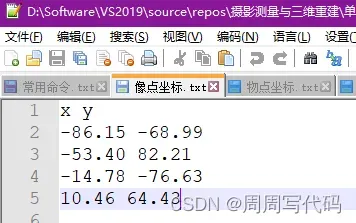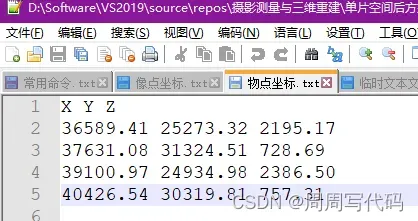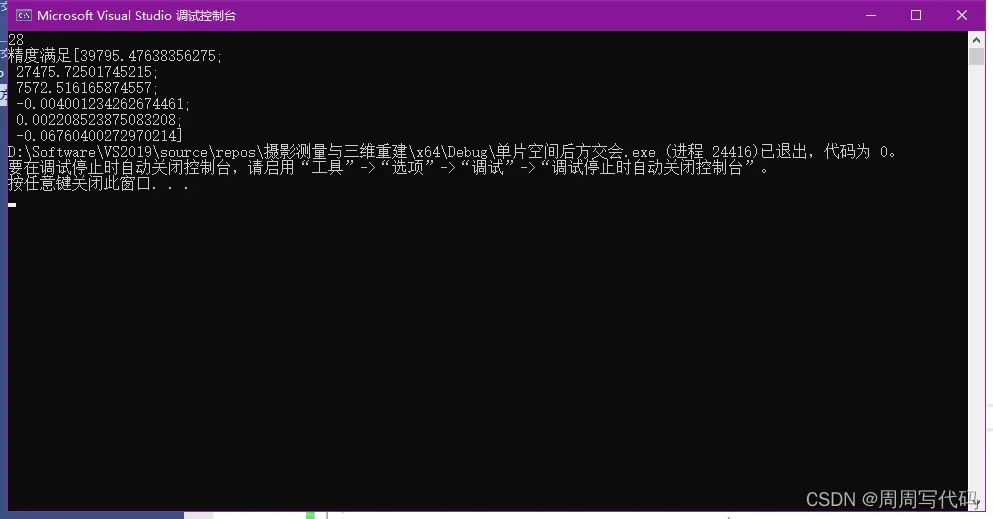学习摄影测量之后一直都很想用代码实现一下这个特别经典的,难度又不是很大的课堂案例,但是由于一直在看其他开源项目的代码,一直被搁置,趁着暑假完成一下曾经的小目标。
没想到这东西看起来步骤清晰且简单,实现起来竟然踩了特别多的坑,主要就是Python中的数组和基于OpenCV的c++Mat这两者用起来差别有点大,搞得我晕头转向的,很难受……

一、Python实现:
我先用Python代码实现了一下,毕竟python代码比较……
#空间后方交会
import numpy as np
m = 50000#比例尺分母
limit = 0.0001#迭代限差
def Space_resection(f, X, Y, Z, x, y, H):
#初始化
x = np.array(x, dtype=np.float32)
y = np.array(y, dtype=np.float32)
X = np.array(X, dtype=np.float32)
Y = np.array(Y, dtype=np.float32)
Z = np.array(Z, dtype=np.float32)
phi = 0
omg = 0
kappa = 0
Xs = sum(X) / 4
Ys = sum(Y) / 4
Zs = m * f
iteration_num = 50000
for i in range(iteration_num):
#计算旋转矩阵元素
a1 = np.cos(phi) * np.cos(kappa) - np.sin(phi) * np.sin(omg) * np.sin(kappa)
a2 = -np.cos(phi) * np.sin(kappa) - np.sin(phi) * np.sin(omg) * np.cos(kappa)
a3 = -np.sin(phi) * np.cos(omg)
b1 = np.cos(omg) * np.sin(kappa)
b2 = np.cos(omg) * np.cos(kappa)
b3 = -np.sin(omg)
c1 = np.sin(phi) * np.cos(kappa) + np.cos(phi) * np.sin(omg) * np.sin(kappa)
c2 = -np.sin(phi) * np.sin(kappa) + np.cos(phi) * np.sin(omg) * np.cos(kappa)
c3 = np.cos(phi) * np.cos(omg)
R = np.mat([[a1, a2, a3], [b1, b2, b3], [c1, c2, c3]])
# print(R)
num = len(x)#物点/像点数量
# print(num)
for j in range(num):
#初始化系数矩阵a,常数项矩阵l和近似值x,y
a11 = np.zeros(num, dtype=np.float32)
a12 = np.zeros(num, dtype=np.float32)
a13 = np.zeros(num, dtype=np.float32)
a14 = np.zeros(num, dtype=np.float32)
a15 = np.zeros(num, dtype=np.float32)
a16 = np.zeros(num, dtype=np.float32)
a21 = np.zeros(num, dtype=np.float32)
a22 = np.zeros(num, dtype=np.float32)
a23 = np.zeros(num, dtype=np.float32)
a24 = np.zeros(num, dtype=np.float32)
a25 = np.zeros(num, dtype=np.float32)
a26 = np.zeros(num, dtype=np.float32)
l11 = np.zeros(num, dtype=np.float32)
l12 = np.zeros(num, dtype=np.float32)
appro_x = np.zeros(num, dtype=np.float32)
appro_y = np.zeros(num, dtype=np.float32)
for j in range(num):
#计算每个点的系数矩阵a,常数项矩阵l和近似值x,y
appro_x[j] = -f * (a1 * (X[j] - Xs) + b1 * (Y[j] - Ys) + c1 * (Z[j] - Zs)) / (
a3 * (X[j] - Xs) + b3 * (Y[j] - Ys) + c3 * (Z[j] - Zs))
appro_y[j] = -f * (a2 * (X[j] - Xs) + b2 * (Y[j] - Ys) + c2 * (Z[j] - Zs)) / (
a3 * (X[j] - Xs) + b3 * (Y[j] - Ys) + c3 * (Z[j] - Zs))
# print(appro_x[j],appro_y[j])
a11[j] = -f / H
a12[j] = 0
a13[j] = -x[j] / H
a14[j] = -f * (1 + (x[j] * x[j]) / (f * f))
a15[j] = -x[j] * y[j] / f
a16[j] = y[j]
a21[j] = 0
a22[j] = -f / H
a23[j] = -y[j] / H
a24[j] = -x[j] * y[j] / f
a25[j] = -f * (1 + (y[j] * y[j]) / (f * f))
a26[j] = -x[j]
#组合A,L
A = np.zeros((2 * num, 6), dtype=np.float32)
for j in range(num):
A[2 * j:2 * j + 2, :] = np.array(
[[a11[j], a12[j], a13[j], a14[j], a15[j], a16[j]], [a21[j], a22[j], a23[j], a24[j], a25[j], a26[j]]])
#print(A)
L = np.zeros((2 * num, 1), dtype=np.float32)
for j in range(num):
L[2 * j:2 * j + 2, :] = np.mat([[x[j] - appro_x[j]], [y[j] - appro_y[j]]])
#print(L)
#计算ATA,ATL以及改正数X=(ATA)-1(ATL)
ATA = np.dot(A.T, A)
ATL = np.dot(A.T, L)
X_mid = np.dot(np.linalg.inv(ATA), A.T)
result = np.dot(X_mid, L)
#求新值
Xs += result[0,0]
Ys += result[1,0]
Zs += result[2,0]
phi += result[3,0]
omg += result[4,0]
kappa += result[5,0]
if (abs(result[0,0]) < limit and abs(result[1,0]) < limit and abs(result[2,0]) < limit and abs(
result[3,0]) < limit and abs(result[4,0]) < limit and abs(result[5,0]) < limit):
print("精度满足")
return (Xs,Ys,Zs,phi,omg,kappa)
else:
print(i)
print("继续")
# print(result)
def main():
f = 153.24 / 1000
H = f * m#航高
x = [-86.15 / 1000, -53.40 / 1000, -14.78 / 1000, 10.46 / 1000]
y = [-68.99 / 1000, 82.21 / 1000, -76.63 / 1000, 64.43 / 1000]
X = [36589.41, 37631.08, 39100.97, 40426.54]
Y = [25273.32, 31324.51, 24934.98, 30319.81]
Z = [2195.17, 728.69, 2386.50, 757.31]
result = Space_resection(f, X, Y, Z, x, y, H)
print(result)
if __name__ == '__main__':
main()
运行结果是这样的:

二、c++实现:
#include <iostream>
#include<fstream>
#include<opencv2/opencv.hpp>
using namespace std;
using namespace cv;
const int m = 50000;//比例尺分母
const double limit = 0.000001;//迭代限差
const int N = 4;//物点/像点个数,根据实际情况修改
const int iteration_num = 50000;//设定的迭代次数
Mat Space_resection(double f, double* x, double* y, double* X, double* Y, double* Z, double H, Mat& result)
{
double sumX = 0.0, sumY = 0.0;
for (int i = 0; i < N; i++)
{
sumX += *(X + i);
}
for (int i = 0; i < N; i++)
{
sumY += *(Y + i);
}
//参数初始化
double phi = 0.0, omg = 0.0, kappa = 0.0;
double Xs = sumX / 4;
double Ys = sumY / 4;
double Zs = m * f;
for (int times = 1; times <= iteration_num; times++)//开始迭代
{
//计算旋转矩阵
double a1 = cos(phi) * cos(kappa) - sin(phi) * sin(omg) * sin(kappa);
double a2 = -cos(phi) * sin(kappa) - sin(phi) * sin(omg) * cos(kappa);
double a3 = -sin(phi) * cos(omg);
double b1 = cos(omg) * sin(kappa);
double b2 = cos(omg) * cos(kappa);
double b3 = -sin(omg);
double c1 = sin(phi) * cos(kappa) + cos(phi) * sin(omg) * sin(kappa);
double c2 = -sin(phi) * sin(kappa) + cos(phi) * sin(omg) * cos(kappa);
double c3 = cos(phi) * cos(omg);
Mat R = (Mat_<double>(3, 3) << a1, a2, a3, b1, b2, b3, c1, c2, c3);
//初始化A,L
double appro_x[N] = { 0 };
double appro_y[N] = { 0 };
double a11[N] = { 0 };
double a12[N] = { 0 };
double a13[N] = { 0 };
double a14[N] = { 0 };
double a15[N] = { 0 };
double a16[N] = { 0 };
double a21[N] = { 0 };
double a22[N] = { 0 };
double a23[N] = { 0 };
double a24[N] = { 0 };
double a25[N] = { 0 };
double a26[N] = { 0 };
double lx[N] = { 0 };
double ly[N] = { 0 };
//逐点计算A,L
for (int j = 0; j < N; j++)
{
appro_x[j] = -f * (a1 * (*(X+j) - Xs) + b1 * (*(Y+j) - Ys) + c1 * (*(Z + j) - Zs)) /
(a3 * (*(X + j) - Xs) + b3 * (*(Y + j) - Ys) + c3 * (*(Z + j) - Zs));
appro_y[j] = -f * (a2 * (*(X + j) - Xs) + b2 * (*(Y + j) - Ys) + c2 * (*(Z + j) - Zs)) /
(a3 * (*(X + j) - Xs) + b3 * (*(Y + j) - Ys) + c3 * (*(Z + j) - Zs));
lx[j] = *(x + j) - appro_x[j];
ly[j] = *(y + j) - appro_y[j];
a11[j] = -f / H;
a12[j] = 0;
a13[j] = -*(x + j) / H;
a14[j] = -f * (1 + (*(x + j) * *(x + j)) / (f * f));
a15[j] = -*(x + j) * *(y + j) / f;
a16[j] = *(y + j);
a21[j] = 0;
a22[j] = -f / H;
a23[j] = -*(y + j) / H;
a24[j] = -*(x + j) * *(y + j) / f;
a25[j] = -f * (1 + (*(y + j) * *(y + j)) / (f * f));
a26[j] = -*(x + j);
}
//组合总的A,L
Mat A(2 * N, 6,CV_64F);
Mat L(2 * N, 1, CV_64F);
int t = 0, t2 = 0;
for (int j = 0; j < 2 * N; j += 2)
{
Mat mid = (Mat_<double>(2, 6) << a11[t], a12[t], a13[t], a14[t], a15[t], a16[t], a21[t], a22[t], a23[t], a24[t], a25[t], a26[t]);
for (int row = 0; row < 2; row++)
{
for (int col = 0; col < 6; col++)
{
A.at<double>(row + 2 * t, col) = mid.at<double>(row, col);
}
}
t++;
}
for (int j = 0; j < 2 * N; j += 2)
{
Mat mid = (Mat_<double>(2, 1) << lx[t2], ly[t2]);
for (int row = 0; row < 2; row++)
{
for (int col = 0; col < 1; col++)
{
L.at<double>(row + 2 * t2, col) = mid.at<double>(row, col);
}
}
t2++;
}
//计算ATA,ATL和X
Mat ATA = A.t() * A;
Mat ATL = A.t() * L;
Mat X = (ATA).inv() * A.t()*L;
//求新值
Xs += X.at<double>(0, 0);
Ys += X.at<double>(1, 0);
Zs += X.at<double>(2, 0);
phi += X.at<double>(3, 0);
omg += X.at<double>(4, 0);
kappa += X.at<double>(5, 0);
//与限差比较
if (fabs(X.at<double>(0, 0)) < limit && fabs(X.at<double>(1, 0)) < limit && fabs(X.at<double>(2, 0)) < limit && fabs(X.at<double>(3, 0)) < limit && fabs(X.at<double>(4, 0)) < limit && fabs(X.at<double>(5, 0)) < limit)
{
cout << times << endl;
cout << "精度满足";
result = (Mat_<double>(6, 1) << Xs, Ys, Zs, phi, omg, kappa);
return result;
}
else
{
result = (Mat_<double>(6, 1) << X.at<double>(0, 0), X.at<double>(1, 0), X.at<double>(2, 0), X.at<double>(3, 0), X.at<double>(4, 0), X.at<double>(5, 0));
}
}//
return result;
}
int main()
{
double f = 153.24 / 1000;
double H = f * m;
ifstream fin1;
ifstream fin2;
//从文件中读取物点坐标,像点坐标
fin1.open("D:\\Software\\VS2019\\source\\repos\\摄影测量与三维重建\\单片空间后方交会\\像点坐标.txt");
fin2.open("D:\\Software\\VS2019\\source\\repos\\摄影测量与三维重建\\单片空间后方交会\\物点坐标.txt");
double x[N];
double y[N];
double X[N];
double Y[N];
double Z[N];
char strx, stry, strX, strY, strZ;
fin1 >> strx >> stry;
for (int i = 0; i < N; i++)
{
fin1 >> x[i] >> y[i];
x[i] /= 1000;
y[i] /= 1000;
}
fin2 >> strX >> strY >> strZ;
for (int i = 0; i < N; i++)
{
fin2 >> X[i] >> Y[i] >> Z[i];
}
Mat result=Mat::zeros(Size(6,1), CV_64F);
Mat final_result(6, 1, CV_64F);
final_result = Space_resection(f, x, y, X, Y, Z, H, result);
cout << final_result;
return 0;
}
这个代码要跑起来需要配置OpenCV库,我用的OpenCV里面的Mat,具体配置过程参考这个吧VS配置OpenCV库。
然后就是考虑到这只是一个小案例,实际生产生活中我们有海量的物点和像点,所以我采用了读取文件的方式,这两个文本文件格式如下:


然后对照着我的代码,应该很容易能看明白。
运行结果如下:和Python的结果差不多,但是就这么一个小程序我都能明显感觉到c++确实比Python运行的快很多。

文章出处登录后可见!
已经登录?立即刷新
